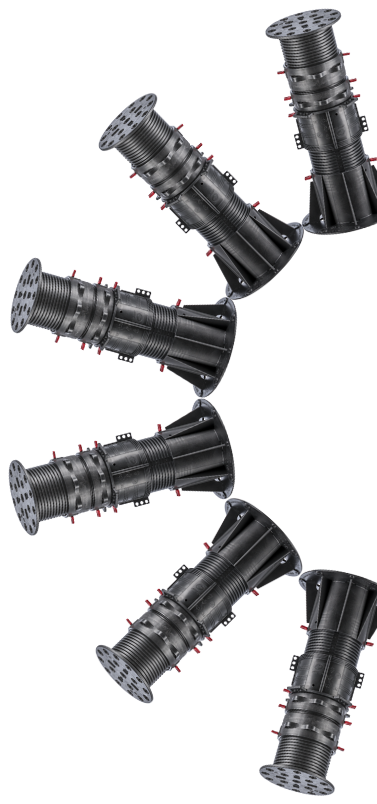Slope correction is a common requirement in most paving and decking applications. Examples include:
- - Building on an incline (and wanting a level surface)
- - Creating a slope for a ramp
Yet, designing for slope correction can be challenging – particularly if you’re in charge of specification. How do I calculate it? How do I know which products will work best?
In this post, we share some key insights that should make your specification process a little easier.
Slope Correction: Functionality to Look Out For
All Buzon pedestals have millimetre-precise slope correction capability. The DPH range and the A-PED have slope correction of up to 5% built into the pedestals, whilst the BC, PB and BC-FR ranges have slope corrector accessories that can be added to the head and/or base of the pedestal, dependent on the range.
So, you can rest assured that slope correction will not be an issue. But, how can you calculate slope correction? Continue reading…
Slope Correction on Roof Terraces
As mentioned in the introduction, slope correction is an essential requirement for roof terraces to allow for the natural drainage of rainwater.
The table below will help you calculate the depth of fall across a terrace:
Roof Slope Conversion Chart
| Percentage | Depth of Fall | Degrees | Gradient |
| 5% | 50 mm / LM | 2.86° | 1:20 |
| 4.5% | 45 mm / LM | 2.58° | 1:22 |
| 4% | 40 mm / LM | 2.30° | 1:25 |
| 3.5% | 35 mm / LM | 2.10° | 1:29 |
| 3% | 30 mm / LM | 1.72° | 1:33 |
| 2.5% | 25 mm / LM | 1.43° | 1:40 |
| 2% | 20 mm / LM | 1.50° | 1:50 |
| 1.5% | 15 mm / LM | 0.86° | 1:67 |
| 1% | 10 mm / LM | 0.60° | 1:100 |
So, if there is a fall of 1%, the height changes by 10mm per linear metre.
That means if your finished floor level is 80mm at the highest point of the terrace and 3 metres to the lowest point, the finished floor level will be 110 mm (80 mm + (3 x 10mm)) at the lowest point of the terrace. A significant difference…
And this will only increase as the fall percentage increases.
For example, a fall of 5% means the finished floor level will be 230 mm (80mm + (3 x 50mm)) at the lowest point of the terrace.
Knowing the highest and lowest points of your terrace is crucial in calculating what pedestal models and accessories are required. The table above should help with that, provided you know the gradient of the slope.
Key Resources & Accessories That Will Help With Slope Correction
In a recent post, we talked about our pedestal calculators. They can be used to help with fairly complex fall patterns but knowing the highest and lowest points of your terrace (as mentioned above) will be necessary.
For each of our ranges – PB, BC and DPH – we have a pedestal calculator which you can use for free.
BC-FR and A-PED calculators will be coming soon.
At this point, it’s useful to know about each of our pedestal ranges and what they can help you achieve. Take a look at this blog post to find out more:
What Pedestal Range Should I Use For My Project?
Each range has its own unique function – worth noting for when you’re conducting product research. Projects with complex falls may require you to use more than one pedestal range.
This Product Will Help You Significantly…
Determining the percentage and direction of the fall can be easily achieved with our slope bubble.
The slope bubble measures the value and direction of the slope at the point of placement.
Take a look at this video to see exactly how it works…
U-PH5 Slope Corrector
Once the appropriate percentage is calculated, the U-PH5 Slope Corrector can be set to the desired incline, locked into position and used at the base of the pedestal, allowing you to maintain the adjustment value of the slope. It is compatible with all of our standard pedestal ranges; we even have a B-rated version (U-PH5-FR) for our self-extinguishing range of pedestals, the BC-FR. If falls greater than 5% need to be catered for, the U-PH5 can be used in multiples of up to 3.
DPH-PH5 Slope Corrector
For our models of DPH adjustable pedestals that do not already have an in-built slope corrector, we also have the DPH-PH5 Slope Corrector.
It fits on the head of the pedestal and can compensate for slopes up to 5% in increments of 0.5% and can be used in conjunction with the U-PH5 base slope corrector, providing correction of up to 15%.
Conclusion
We always recommend a site survey to determine exact requirements, but this post should provide an insight into the importance of slope correction – and some essential tools you can use to help calculate and achieve slopes and inclines on your project.
For any further information, speak to an expert today.














